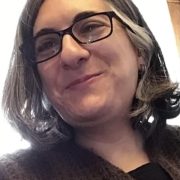Are you “up to your neck” in a project or in stash?
Perhaps you’re concentrating instead, and you’ve hunched up your shoulders practically to your ears.
That experienced spinner at the guild meeting, she stands “head and shoulders” above the rest.
When you start a project by consulting a historic textile piece, do you feel as though you are simply “standing on the shoulders of giants” – those incredible spinners who came before us?
Yes, these clichés can be silly, but every language has its idioms. We’re reflecting how we feel and experience things when we suggest we’re up to our neck in a project or find our shoulders tensed up to our ears.
Even spinning can be full of moments where we feel overwhelmed, awed, or stressed. In English, we often express these things through references to our neck and shoulders. When thinking about the theme for this quarter’s issue of PLY, product/project spinners may aim to produce more shrugs, cowls, and shawls because these are things that cover the neck and shoulders.
Okay, but what about those spinners who focus on the process more than the project? It might be time to look towards our necks and shoulders to find answers instead. Process spinners may need to think about how they feel and what they gain by spinning on the topic of neck and shoulders.
When I thought about neck and shoulders in the context of handspinning, I thought of all the ways our bodies move and react as we spin for projects. Our neck and shoulders are essential for spinning. They reflect our thoughts as we spin. Process spinners might not aim for a cowl at the end, but rather, to untangle the tense muscles or feelings of intimidation they face when considering those who came before.
We can address things like feeling overwhelmed. If the stash feels as if it is overtaking the house or a difficult project feels like too much, we can calm down by taking time to organize and complete one step at a time. When our space is tidier or we iron out the steps to get from fleece to finished project, many might feel their shoulders drop or relax. This is something we can do on our own.
What of the intimidation we feel when meeting a spinning expert or the awe that comes from handling a handspun, handmade textile from the past? Again, the sense of tension, the sense that we are hunched over in admiration, might come to mind. There is both the excitement of a chance to learn from a mentor and a sense of being less than or behind or as though we’ve just started learning.
I find putting that excited anxiety into context helps me. Often, in the course of learning from a spinning mentor, I’m reminded again how we all grow and develop over time. Sometimes we receive the gift of knowledge from others, and sometimes we can offer it onwards. Knowing we are part of a chain of learning helps make these moments feel less fraught with tension. Historically, all spinners were part of that chain of ancestors, but they had the burden of desperation because they needed that yarn production to survive. The museum examples of knitted or woven goods not only reflect many years of practice and skill but also a couple of other things.
Twist redistributes over time. That is to say, a yarn that once had high twist and low twist spots evens out over time, with wear. Knitted stitches even out in much the same way, with use. Also, whatever older textile you might see in a museum was either something a person saved as “extra special” or possibly was not as comfortable as another item. Our most worn and beloved garments don’t last to end up in museum collections. They are worn into tatters with love.
When we remember that every yarn or stitch is connected, we have the best tip ever for our spinner necks and shoulders. Just as we’re connected to those who come before us, to our stashes and projects, our necks and shoulders are also connected to our brains and other parts of our bodies. To stay healthy, well, and productively spinning, we must listen to those connections. Whether it’s a funny cliché phrase or a sore arm, our minds and bodies are interconnected. If we just focus on finishing the next shawl project without listening to what it means, in our bodies and minds, we’ve left part of ourselves behind.
Joanne Seiff is the author of three fiber books. She writes, edits, spins, knits, designs, and teaches in Winnipeg, Manitoba. Her knitwear designs, on Ravelry, Lovecrafts, and Payhip, just might sing in your handspun! See more about Joanne on Instagram @yrnspinner or her blog, joanneseiff.blogspot.com.





Leave a Reply
Want to join the discussion?Feel free to contribute!